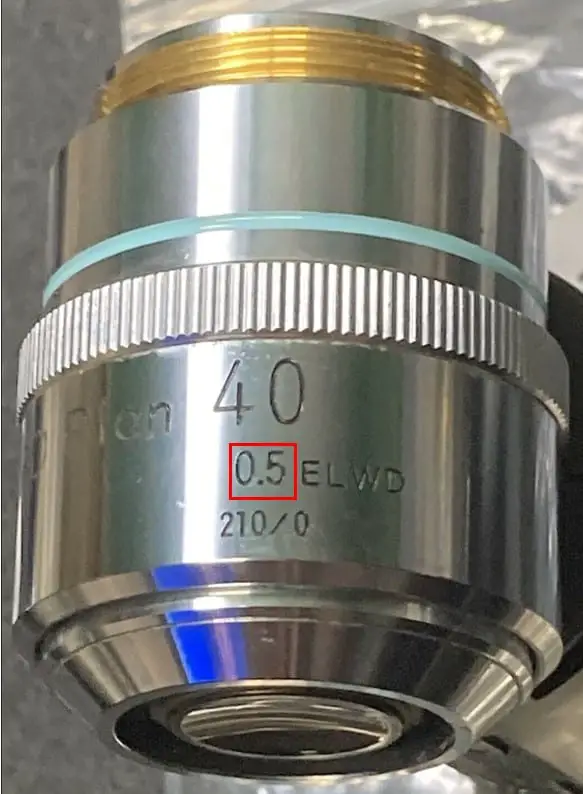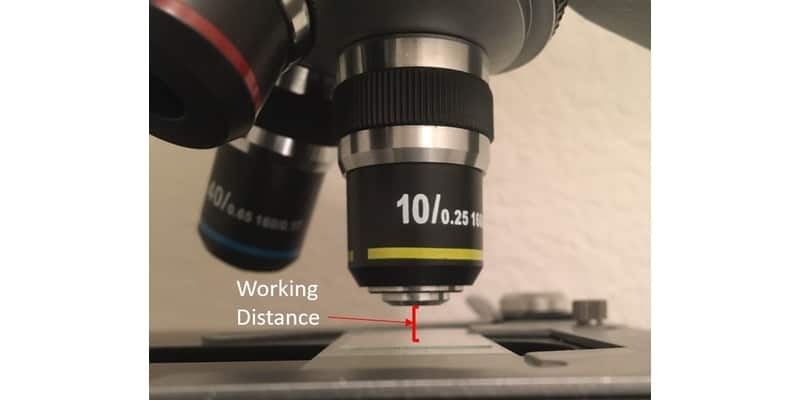If you have ever accidentally bumped your objective lens against a slide and were extremely grateful the objective had a spring-loaded nosecone, you probably already know how important the distance between the objective lens and slide can be.
Working distance is the distance between the front of the microscope objective lens and the surface of the specimen or slide coverslip at the point where the specimen is completely in focus. As a general rule working distance decreases and total magnification increases due to the higher numerical apertures associated with high power objectives. Working distances can vary among objective lenses depending on the manufacturers even for objectives of the same magnification level.
Working distance is an important topic to understand when using a microscope. Understanding the tradeoffs can be the difference between buying an objective that is tedious and nerve-wracking to use versus one that works very well for the intended purpose. In this post I will take you through all the concepts and nuances related to working distance and how you can utilize that knowledge to find an objective that is right for your needs.
How to Find the Working Distance for an Objective Lens
There are two ways I would recommend finding the working distance of an objective lens. The first is to check to see if it is inscribed on the objective barrel. The inscription will be have the letters “WD” which is short for “working distance” followed by the length in millimeters like this: “WD: 0.5” or “0.5 EL WD”. This indicates that the working distance for the objective is 0.5 millimeters. So, when you use the objective and you are in sharp focus you know that the objective lens is 0.5 millimeters away from the slide coverslip.

The second way I would recommend finding the working distance is one the manufacturer specifications. This will typically come with the objective lens or be posted on the manufacturer website. The working distance will be a section in the specification sheet and will state the working distance for each objective.
If you cannot find the working distance using these two methods, there is a third way, but I would not recommend doing this because you could easily damage or smudge the surrounding objective lenses. You could take a digital caliper and carefully get as close as you can to the objective and measure the working distance that way. Again, I would not recommend this but if you really want to know, that would be a way you could find out.
Why is Working Distance Important?
Imagine if you wanted to observe a specimen that was not completely flat or emitted toxic fumes or contaminates. Would you want your expensive objective to be closer or further away from that specimen? Obviously, you would want your objective lens to be further away. A longer working distance can provide a unique advantage when observing specimens where more distance from the objective is desirable.
However, because higher power objective lenses require a higher numerical aperture, they must be closer to the light source and specimen. Manufacturers who design long working distance objective must balance the need for a higher numerical aperture with the aberration corrections required to achieve the longer working distance.
Longer working distance objectives can also reduce the risk of damage for higher power objectives because they can be further away. Although using the fine adjustment knob when focusing under high power objectives can prevent the majority of damage, there are still cases where I have found myself accidentally hitting my objective lens against the slide coverslip.
What are Long Working Distance Objective Lenses?
Long working distance objectives are specialized objectives that are designed to focus at longer working distances compared to traditional objective lenses. Long working distance objectives correct for aberrations that would occur as a result of the longer distance. The table below shows the differences in working distances from standard achromatic objectives and long working distance plan achromatic objectives.
| Objective Type | Magnification | Working Distance (mm) |
|---|---|---|
| Achromatic | 4X | 37.4 |
| Achromatic | 10X | 6.6 |
| Achromatic | 40X | 0.64 |
| Achromatic | 100X (Oil) | 0.19 |
| LWD Plan Achromatic | 4X | 11.98 |
| LWD Plan Achromatic | 10X | 11 |
| LWD Plan Achromatic | 40X | 2.9 |
| LWD Plan Achromatic | 100X (Oil) | 0.12 |
Long working distance objectives tend to cost more but if you don’t have to replace an objective because you have scratched or broken the lens, it can more than pay for the investment.
Check out the price of this long working distance 40X plan infinity corrected objective. That set of long working distance plan achromatic objectives will be my next set of objectives I buy myself. I have had my eye on these for a while. Not only do you get the optical upgrade to the plan objective, but the added bonus is that they are also long working distance.
Which Objective Lens Has the Shortest Working Distance?
The objective lens with the shortest working distance is the 100X objective lens. The 100X objective lens is typically an oil objective which means it must be immersed in oil for the required numerical aperture to be attained.
As you can imagine you have to be very close to the slide coverslip to immerse the tip of the objective nosecone in oil without it touching the slide. There are even 100X dry objectives that do not require oil immersion but will still have a short working distance. This 100X dry objective from LW scientific is an example of a dry objective that would not require oil immersion and would have a longer working distance than the traditional oil immersion objective.
Takeaways
Working distance is an important concept to understand and take into account when using your microscope and when determining which objective lenses to purchase. The higher the magnification the shorter the working distance and the closer you are going to have to get the objective lens to the specimen or slide coverslip. If you’re worried about the safety of your objectives it may be time to lengthen the working distance of your objectives by upgrading them to some long working distance objectives.

